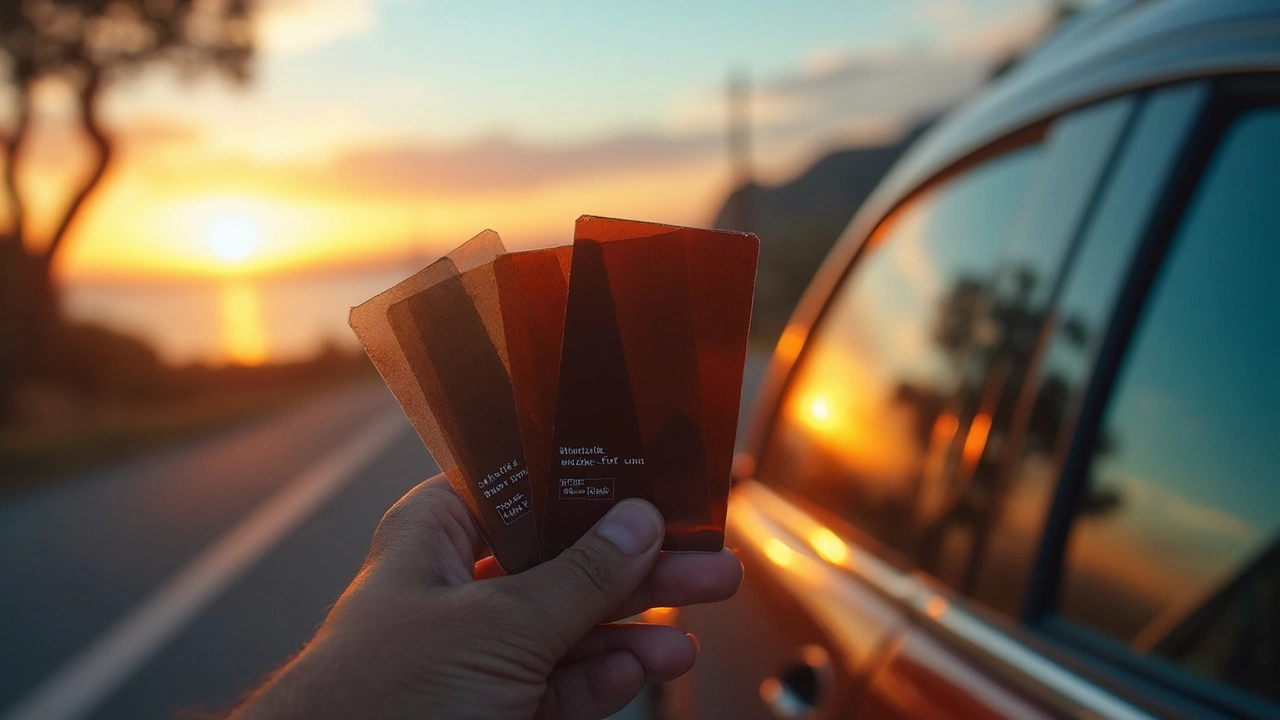Legal Window Tint Standards in California Explained
 Mar, 29 2025
Mar, 29 2025
So, you're thinking about tinting your car windows in California? Cool idea! But a quick heads-up: California's got some pretty specific rules about how dark you can go with that tint. You see, it’s not just about looking sleek; it’s about safety on the road. Too dark, and you might find yourself on the wrong side of a traffic stop—and no one wants to deal with that!
First off, let's talk numbers. When people mention tint percentages, they’re talking about Visible Light Transmission (VLT)—the amount of light that can pass through the window. In California, your front side windows need to let in more than 70% of light. Oh, and don’t even think about tinting the windshield with anything but a special strip at the top. The back windows and rear windshield? You’ve got more flexibility there, but we'll get into those specifics later.
Why does this matter? Well, it’s about visibility—yours and other drivers’. If your windows are too dark, it can really impact your ability to see at night or in poor weather. Plus, cops need to be able to see inside, which helps for traffic stops and overall safety on the roads.
- Understanding Tint Percentages
- Legal Tint Limits for Different Windows
- Benefits of Staying Legal
- What Happens if You Break the Rules?
- Practical Tips for Choosing Your Tint
Understanding Tint Percentages
Alright, let’s break down those tint percentages. When we're talking about window tinting percentages, we're referring to the Visible Light Transmission or VLT. It’s basically how much light gets through your car windows. A higher percentage means more light comes in, and a lower percentage means less light.
In California, the VLT percentage tells you how legit your tint is under the law. For those front side windows, you need a tint that lets in at least 70% of light. That’s even brighter than your average office window, believe it or not. Don’t think this gives you free rein on the other windows though—they’ve got rules too.
As you go to tint shops, you might hear options like '5% tint' or '50% tint'. A 5% tint is super dark, basically like a pair of blackout shades where you can’t see in at all. On the flip side, 50% tint is much lighter and doesn't make much of a difference in terms of privacy but is still noticeable.
Here’s a simple chart to help you get a grip on how different tints look and what they mean in terms of light allowed:
| Type of Tint | VLT Percentage | Visibility |
|---|---|---|
| Standard Clear Glass | ~80-90% | High Visibility |
| California Legal Front You | 70% | Moderate Visibility |
| Private Tint | 5-20% | Low Visibility (Illegal for Front) |
So why stick to these rules? It's simple: safety and saving yourself from a ticket. Getting pulled over for illegal tint might mean peeling it off or paying a fine, and that's not fun. Pick a VLT percentage that keeps things copacetic with the California window tint law and secures a blend of safety and style.
Legal Tint Limits for Different Windows
Alright, let’s crack open the rule book on California window tint law, because understanding what’s legal can save you from a heap of trouble. Different windows on your car have different rules, so it pays to know them.
Now for the front side windows, California says the tint must let in more than 70% of light. This is your chance to keep a bit of sunlight at bay while still staying on the right side of the law. Remember, these are the windows you most frequently look through, so visibility is key.
Moving around the car, your rear windows and rear windshield have more leeway. You can go as dark as you want back here, which is great if you’re carting around precious cargo you’d like to shield from the California sunshine. It might seem confusing, but basically, the tint on these windows doesn’t impact the driver’s immediate visibility as much, hence the relaxed rules.
That said, there are also rules about car window tinting reflection. California law states that the film cannot be more reflective than a standard window. This means those super shiny, mirror-like tints are a no-go. The idea is to reduce glare and not distract other drivers who might catch a flash of your blingy windows.
Just so you have a clearer picture, check out this quick rundown in table form:
| Window Type | Legal Tint Percentage | Reflection Rule |
|---|---|---|
| Front Side Windows | More than 70% light must pass | No more reflective than a standard window |
| Rear Windows | Any darkness allowed | No more reflective than a standard window |
| Rear Windshield | Any darkness allowed | No more reflective than a standard window |
So, next time you’re considering how dark to go on your next California window tint job, keep these rules in mind and you’ll be cruising stylishly and legally.

Benefits of Staying Legal
Sticking to the California window tint law might not sound exciting, but doing so comes with some real perks. First up, by following the rules, you’re dodging those annoying fines. Sure, it might be tempting to darken up those windows for that mysterious look, but getting pulled over and having to peel it all off sucks. Those fines can put a real dent in your wallet!
Safety is another biggie. With the law requiring a certain amount of light to pass through, you’re ensuring your visibility isn’t compromised. Think about it, you’re driving at night or in bad weather—having enough light coming through makes a massive difference.
Let’s not forget about insurance. If you’ve got illegal tints and get into an accident, your insurance could actually refuse to cover the claim. They might see it as an unnecessary risk you’ve added, which means total hassle for you.
Oh, and while it may sound boring, staying within the legal limits also ups your car's resale value. Potential buyers trust that the car hasn’t been messed with in ways that could get them into trouble down the road.
And last but not least, there are eco and health benefits. Legal tint levels can reduce glare and keep UV rays at bay, helping you avoid sunburn while sitting in traffic. It's a small boost for your health and comfort.
- Avoid fines and tickets by adhering to legal tint limits.
- Enhance safety with better visibility.
- Maintain insurance coverage without hiccups.
- Boost your car’s resale value.
- Enjoy protection from UV rays without risking compliance.
What Happens if You Break the Rules?
Alright, so you've joined the rebel squad and gone darker with your tint than California window tint law allows? Here's what could happen. First off, if you're stopped by law enforcement, they might just give you a fix-it ticket—that's like a warning. You're supposed to fix the issue by removing or replacing the illegal tint, and then get an officer to sign off saying you did.
If you decide to ignore a fix-it ticket, things can get a little more intense. Ignoring the first ticket can turn it into a hefty fine. Seriously, we’re talking hundreds of dollars, not exactly chump change!
You might also get ticketed again in the future if you keep driving with that illegal tint. Each ticket can come with its own pretty expensive fine. So, even though it might seem like the initial investment for a top-notch tint job was worth it, running afoul of the car window tinting regulations can cost way more in the long run.
But wait, there's more. If you're in an accident and your tint is a factor, insurance might have a field day with you. They could deny your claim if they think your too-dark windows contributed to the incident. That legal tint percentage isn't just a guideline; it's there to keep everyone safer.
In summary, playing by the rules might not just save you from paying fines, but it could keep you out of a sticky situation if you ever find yourself involved in a fender bender. Better to play it safe and keep that California tint limits guide by your side when choosing your tint.

Practical Tips for Choosing Your Tint
Picking the right tint for your car isn’t just about avoiding run-ins with the law—it’s also about getting the most out of your ride in terms of comfort and style. Here’s how to nail that choice.
First, figure out what you really need. Is your main goal to reduce glare from the sun, add some privacy, or keep the car cool during those blazing hot California summers? Knowing your priorities will help you select the California tint limits that work best for you.
Check out different types of tint materials. There’s everything from dyed films, which are super budget-friendly but might not last as long, to ceramic films that offer the best heat reduction without darkening your windows too much. Ceramic’s the priciest option but it’s also the top choice if you want advanced performance.
Read reviews or get recommendations for local shops specializing in car window tinting. A good installer can make all the difference in the durability and look of your tint. Bad jobs can peel or bubble, leaving you with a mess that could also lead to having to remove and reapply film—double the effort and cost!
This might sound obvious, but double-check that what you're planning fits within California's window tint law constraints. Mistakes here can lead to fines or the expense of removing the illegal tint. Double-check those legal window tint standards—it'll save you a headache later on.
Consider applying a multi-tone tint, which can go lighter on the front side windows and darker on the rear. It’s a sleek look that stays within regulation and maximizes performance wherever you need it most.
And here's a bonus tip: ask about warranty options when choosing your tint. Some come with guarantees against fading or peeling, which is a sweet deal in the long run, especially if you're going for a higher-end film.
With these tips in pocket, your ride’s gonna look awesome and stay on the complaint side of the road rules. No hassles, just stay savvy!